2015届九年级中考语法专项复习课件:十二、句子的种类(共28张PPT)
文档属性
| 名称 | 2015届九年级中考语法专项复习课件:十二、句子的种类(共28张PPT) | 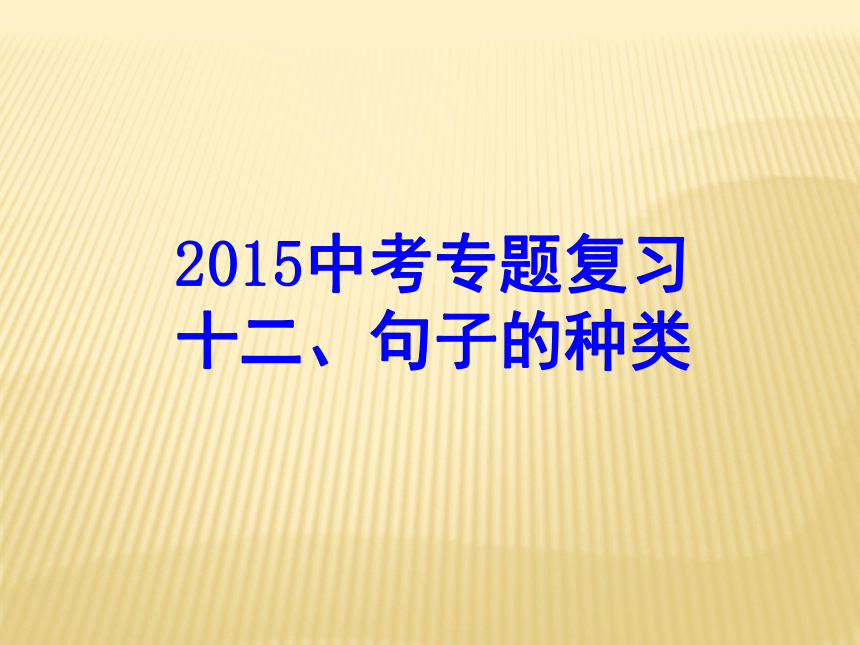 | |
| 格式 | zip | ||
| 文件大小 | 182.7KB | ||
| 资源类型 | 教案 | ||
| 版本资源 | 通用版 | ||
| 科目 | 英语 | ||
| 更新时间 | 2015-06-01 09:02:59 | ||
图片预览

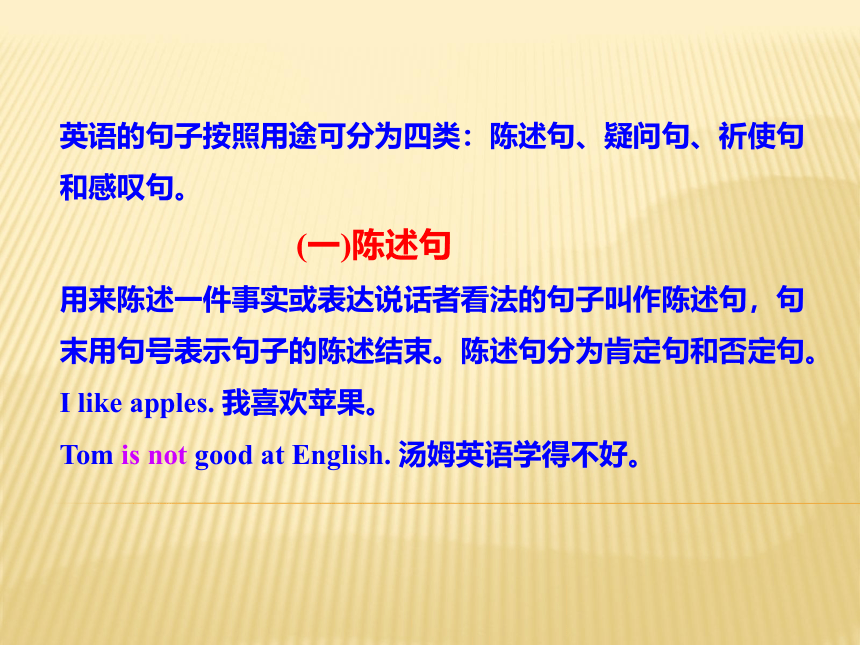
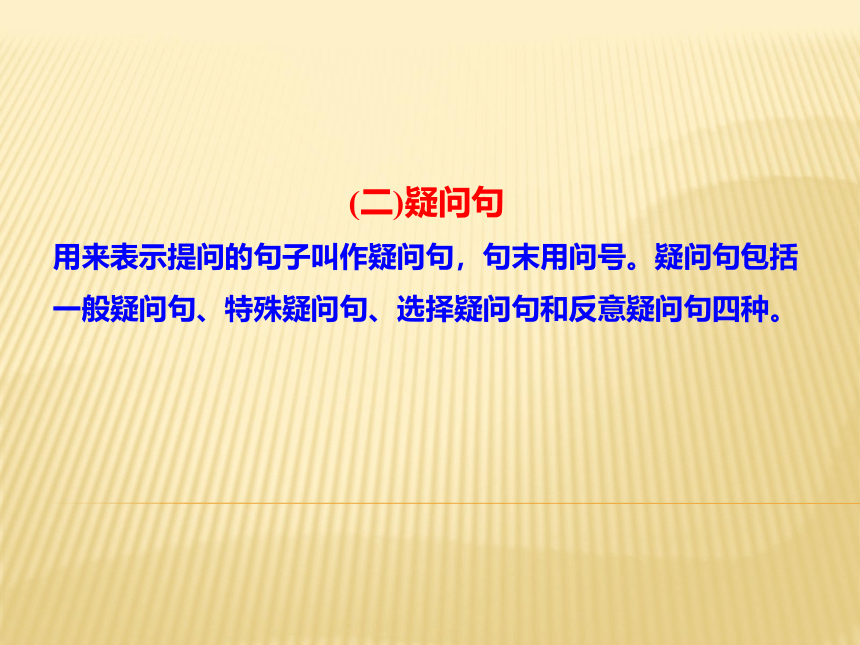
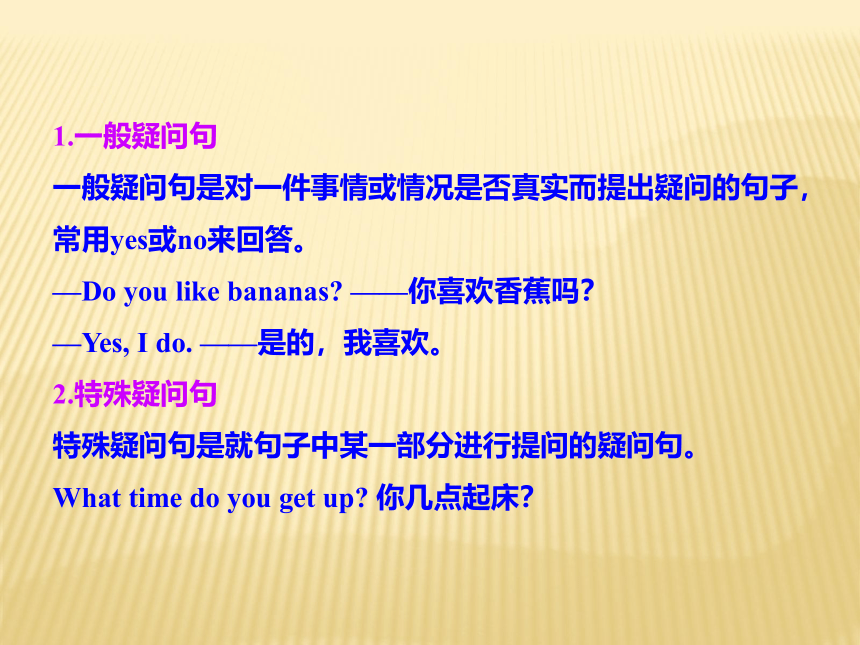

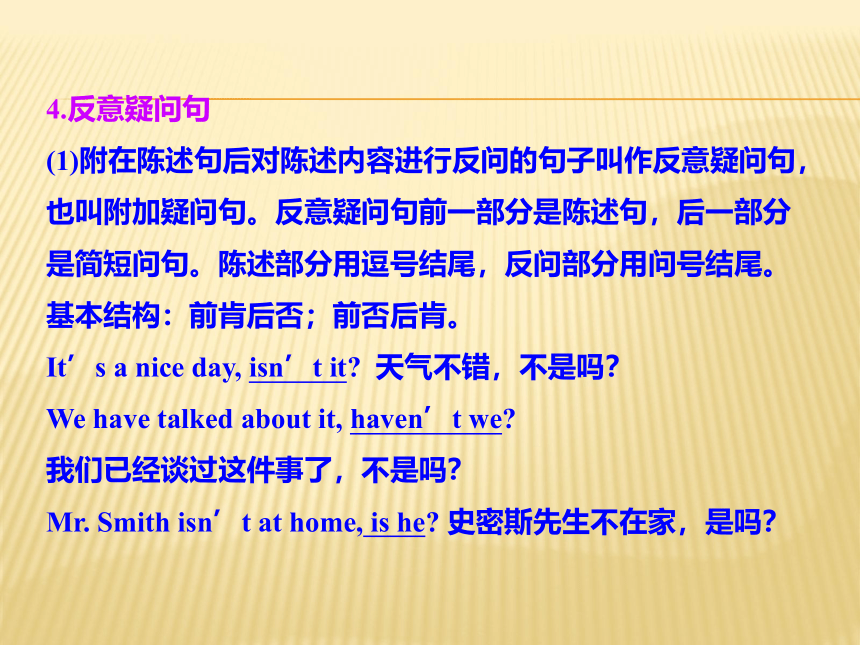
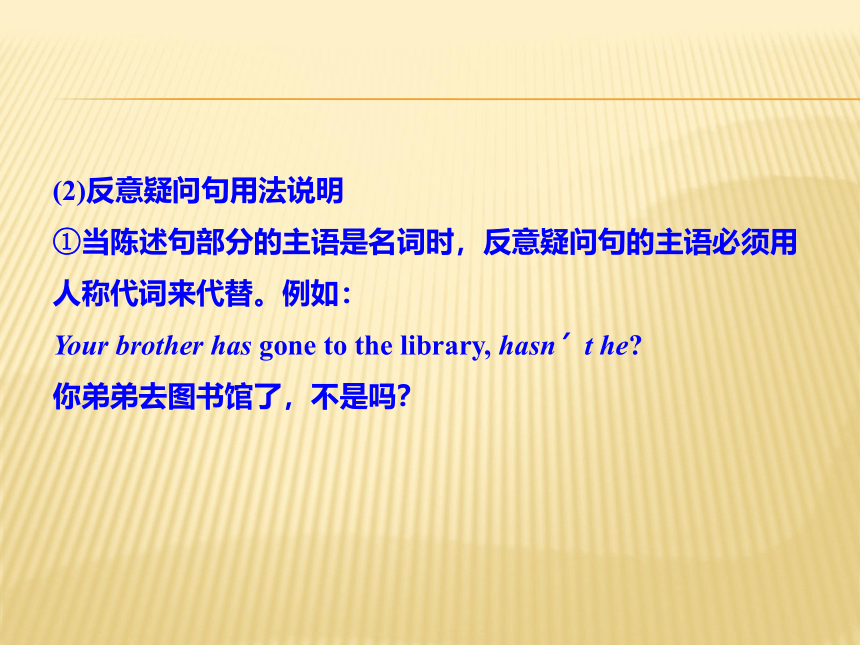
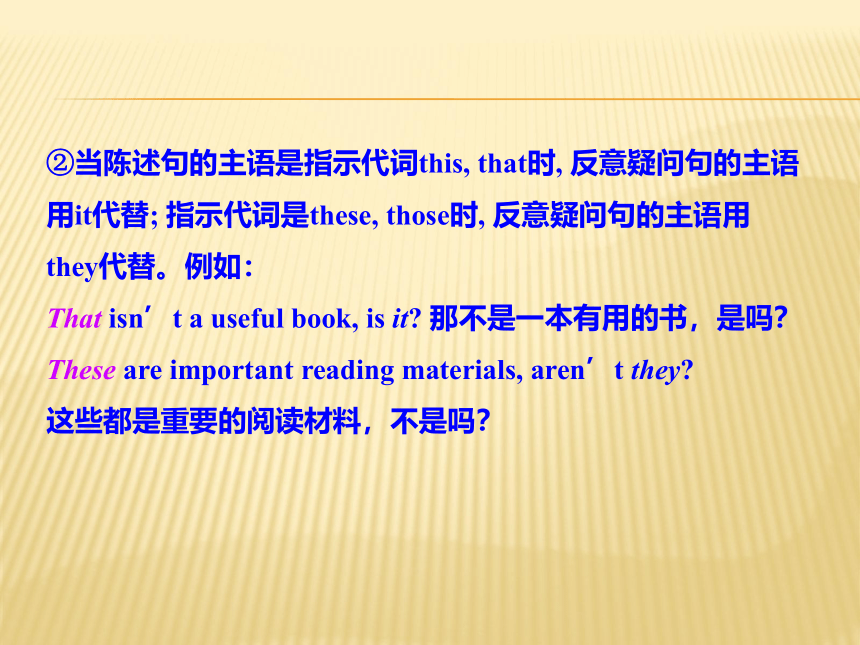

文档简介
课件28张PPT。2015中考专题复习
十二、句子的种类英语的句子按照用途可分为四类:陈述句、疑问句、祈使句和感叹句。 (一)陈述句 用来陈述一件事实或表达说话者看法的句子叫作陈述句,句末用句号表示句子的陈述结束。陈述句分为肯定句和否定句。 I like apples. 我喜欢苹果。 Tom is not good at English. 汤姆英语学得不好。 (二)疑问句
用来表示提问的句子叫作疑问句,句末用问号。疑问句包括一般疑问句、特殊疑问句、选择疑问句和反意疑问句四种。1.一般疑问句
一般疑问句是对一件事情或情况是否真实而提出疑问的句子,常用yes或no来回答。
—Do you like bananas? ——你喜欢香蕉吗?
—Yes, I do. ——是的,我喜欢。
2.特殊疑问句
特殊疑问句是就句子中某一部分进行提问的疑问句。
What time do you get up? 你几点起床?3.选择疑问句
用来在两种或两种以上情况中进行选择的疑问句叫作选择疑问句。答语不能用yes或no回答,而应从问句中选择一种情况进行回答。
Are you a teacher or a doctor?
你是一名老师还是一名医生?
Which do you like better, tea or coffee?
茶和咖啡你更喜欢哪一种? 4.反意疑问句
(1)附在陈述句后对陈述内容进行反问的句子叫作反意疑问句,也叫附加疑问句。反意疑问句前一部分是陈述句,后一部分是简短问句。陈述部分用逗号结尾,反问部分用问号结尾。基本结构:前肯后否;前否后肯。
It’s a nice day, isn’t it? 天气不错,不是吗?
We have talked about it, haven’t we?
我们已经谈过这件事了,不是吗?
Mr. Smith isn’t at home, is he? 史密斯先生不在家,是吗? (2)反意疑问句用法说明
①当陈述句部分的主语是名词时,反意疑问句的主语必须用人称代词来代替。例如:
Your brother has gone to the library, hasn’t he?
你弟弟去图书馆了,不是吗?②当陈述句的主语是指示代词this, that时, 反意疑问句的主语用it代替; 指示代词是these, those时, 反意疑问句的主语用they代替。例如: That isn’t a useful book, is it? 那不是一本有用的书,是吗? These are important reading materials, aren’t they? 这些都是重要的阅读材料,不是吗? ③当陈述句部分是I am…时, 反意疑问句部分通常要用aren’t I; 如陈述句部分是I am not时, 反意疑问句部分通常要用am I。例如: I’m late for the meeting, aren’t I ? 我开会迟到了,不是吗? I’m not doing well, am I ? 我干得不好,是吗? ④当陈述部分是everyone / everybody, someone / somebody, no one / nobody, none等表示人的不定代词时, 反意疑问句部分的主语多用they(但有时也可用he); 当陈述部分的主语是everything, anything, something, nothing等表示物的不定代词时, 反意疑问句部分的主语用it。例如: Nobody came when I was out, did they ? 我在外时, 没人来过, 是吗? Everything has gone wrong today, hasn’t it ? 今天什么都出问题了, 不是吗? ⑤当陈述部分是“there be + 主语 + 其他”结构时, 反意疑问部分要用“be (not) + there”结构。例如: There are some bananas in the basket, aren’t there ?
篮子里有些香蕉, 不是吗? ⑥当陈述部分有hardly, seldom, few, little, no, never, nothing, nobody, nowhere等否定词或半否定词时,反意疑问句部分要用肯定形式。
He hardly remembers his old friend’s name, does he ? 他几乎不记得他的老朋友的名字了, 对吗? ⑦如果陈述句部分带有否定前缀或后缀时,反意疑问句部分仍用否定结构。
It’s impossible for him to make such a mistake, isn’t it ? 他不可能犯这样的错误, 是吗?⑧在宾语从句中,如果陈述句部分是“I think(believe, suppose, imagine, expect等)+ 宾语从句”, 反意疑问句部分应与宾语从句的主谓保持一致, 并要注意否定转移。
I don’t think you have heard of him before, have you?
我认为你以前没有听说过他,是吗?
注: 当think等这些动词的主语不是第一人称, 或主语是第一人称, 而动词时态不是一般现在时或一般过去时时, 反意疑问句的助动词和人称代词要与主句保持一致。
Mary thinks you will come to the party, doesn’t she?
玛丽认为你将来参加晚会, 不是吗? (3)对反意疑问句的回答
对反意疑问句的回答,无论问题的提法如何,如果事实是肯定的,就用yes,事实是否定的,就要用no。要特别注意陈述句部分是否定结构,反意疑问句部分用肯定式提问时,回答yes或no与汉语正好相反。这种省略回答的yes要译成“不”,no要译成“是”。—He likes playing football, doesn’t he?
——他喜欢踢足球,不是吗?
—Yes, he does. / No, he doesn’t.
——是的,他喜欢。/不,他不喜欢。
—His sister didn’t attend the meeting, did she?
——他妹妹没有参加会议,是吗?
—Yes, she did. / No, she didn’t.
——不,她参加了。/是的,她没参加。(三)祈使句
祈使句表达说话人对对方的劝告、叮嘱、建议、请求或命令等。主语you通常省略,谓语动词用原形,句末用感叹号或句号。表达请求或劝告时,祈使句句末或句首可以加上please表示委婉的语气。1.肯定祈使句的表现形式: 2.否定祈使句的表现形式
(1)Do型和Be型的否定式都是在句首加don’t构成。
①Don’t forget me! 不要忘记我!
②Don’t be late for school! 上学不要迟到!
(2)Let型的否定式有两种:
“Don’t +let+宾语+动词原形+其他成分”和“Let+宾语+not+动 词原形+ 其他成分”。
Don’t let him go./Let him not go. 别让他走。
(3)有些可用no开头,用来表示禁止性的祈使句。
No smoking! 禁止吸烟!(四) 感叹句
1.感叹句的概念 感叹句是表示喜怒哀乐等感情的句子,感叹句用感叹号“!”,读句子时用降调。例如:What a clean room! 多么干净的房间! 2.感叹句的种类 感叹句一般用what 或how开头,其具体用法如下: (1) what引导的感叹句 ①What +a/an+ 形容词+可数名词单数(+主语+谓语)!
例如:What a cold day! 多么冷的一天啊! ②What+形容词+可数名词复数(+主语+谓语)!
例如:What clever monkeys! 多么聪明的猴子! ③What+形容词+不可数名词(+主语+谓语)!
例如:What cold weather it is! 多么寒冷的天气!(2) how引导的感叹句
①How + 形容词/副词+主语+谓语!
How clever the boy is! 这个孩子是多么聪明!
②How+ 形容词+a/an+可数名词单数(+主语+谓语)!
How cold a day it is! 多么冷的一天啊!
③How+主语+谓语!
How he snores! 他打鼾是多么厉害啊! 模拟演练
1. _____ sleep too late. It’s bad for your health.
A. Do B. Not C. Don’t D. Please not
【解析】选C。题意为“别睡得太晚。对你的健康没有好
处。” 否定祈使句是在动词原形之前加don’t。
2. Just _____ here and don’t go around, or your parents
can’t find you.
A. to stay B. stayed C. stay D. staying
【解析】选C。题干的前半部分无主语,可以判定是祈使
句,只有C选项是动词原形,故选C项。3. _____ weather it is! Let’s go out for a picnic.
A. What good B. What bad
C. How good D. How bad
【解析】选A。由句子Let’s go out for a picnic. 可知天气很
好,再根据谓语之前的weather是不可数名词,故用what。4. — You’re new here, _____ ?
—Yes, I’m from Dujiangyan. I came here last week.
A. do you B. don’t you
C. are you D. aren’t you
【解析】选D。由陈述部分为肯定句,因此后面用否定形式
进行反问,可以排除A和C选项。再由前面陈述部分的谓语
是be动词,因此可以确定答案为D。5. — _____ you _____ out the problem, Sam?
—Not yet, but I’m going to.
Did;work B. Are; working
C. Have; worked D. Will ;work
【解析】选C。由答语“Not yet” 可知句子的时态为现在
完成时。6. — _____ did you tell him about the news?
—By _____ an e-mail.
How; sending B. How; send
C. How; sent D. What; sending
【解析】选A。根据答语可知特殊疑问词为How;by是介
词,因此后面用动名词作宾语。7. — _____ do you go hiking?
—Once a week.
A. How many times B. How often
C. How long D. How soon
【解析】选B。根据答语是Once a week可知特殊疑问词为 How often。故选B。8. — _____ have you learned to play the guitar?
—For three years.
A. How long B. How often
C. How soon D. How much
【解析】选A。由答语是For three years可知特殊疑问词为How long。
9. Which one is heavier, the wooden ball _____ the iron ball?
A. or B. and C. but D. so
【解析】选A。题意为“木球和铁球哪一个更重?” 选择疑问句中的选项需要用or连接,故选A。
十二、句子的种类英语的句子按照用途可分为四类:陈述句、疑问句、祈使句和感叹句。 (一)陈述句 用来陈述一件事实或表达说话者看法的句子叫作陈述句,句末用句号表示句子的陈述结束。陈述句分为肯定句和否定句。 I like apples. 我喜欢苹果。 Tom is not good at English. 汤姆英语学得不好。 (二)疑问句
用来表示提问的句子叫作疑问句,句末用问号。疑问句包括一般疑问句、特殊疑问句、选择疑问句和反意疑问句四种。1.一般疑问句
一般疑问句是对一件事情或情况是否真实而提出疑问的句子,常用yes或no来回答。
—Do you like bananas? ——你喜欢香蕉吗?
—Yes, I do. ——是的,我喜欢。
2.特殊疑问句
特殊疑问句是就句子中某一部分进行提问的疑问句。
What time do you get up? 你几点起床?3.选择疑问句
用来在两种或两种以上情况中进行选择的疑问句叫作选择疑问句。答语不能用yes或no回答,而应从问句中选择一种情况进行回答。
Are you a teacher or a doctor?
你是一名老师还是一名医生?
Which do you like better, tea or coffee?
茶和咖啡你更喜欢哪一种? 4.反意疑问句
(1)附在陈述句后对陈述内容进行反问的句子叫作反意疑问句,也叫附加疑问句。反意疑问句前一部分是陈述句,后一部分是简短问句。陈述部分用逗号结尾,反问部分用问号结尾。基本结构:前肯后否;前否后肯。
It’s a nice day, isn’t it? 天气不错,不是吗?
We have talked about it, haven’t we?
我们已经谈过这件事了,不是吗?
Mr. Smith isn’t at home, is he? 史密斯先生不在家,是吗? (2)反意疑问句用法说明
①当陈述句部分的主语是名词时,反意疑问句的主语必须用人称代词来代替。例如:
Your brother has gone to the library, hasn’t he?
你弟弟去图书馆了,不是吗?②当陈述句的主语是指示代词this, that时, 反意疑问句的主语用it代替; 指示代词是these, those时, 反意疑问句的主语用they代替。例如: That isn’t a useful book, is it? 那不是一本有用的书,是吗? These are important reading materials, aren’t they? 这些都是重要的阅读材料,不是吗? ③当陈述句部分是I am…时, 反意疑问句部分通常要用aren’t I; 如陈述句部分是I am not时, 反意疑问句部分通常要用am I。例如: I’m late for the meeting, aren’t I ? 我开会迟到了,不是吗? I’m not doing well, am I ? 我干得不好,是吗? ④当陈述部分是everyone / everybody, someone / somebody, no one / nobody, none等表示人的不定代词时, 反意疑问句部分的主语多用they(但有时也可用he); 当陈述部分的主语是everything, anything, something, nothing等表示物的不定代词时, 反意疑问句部分的主语用it。例如: Nobody came when I was out, did they ? 我在外时, 没人来过, 是吗? Everything has gone wrong today, hasn’t it ? 今天什么都出问题了, 不是吗? ⑤当陈述部分是“there be + 主语 + 其他”结构时, 反意疑问部分要用“be (not) + there”结构。例如: There are some bananas in the basket, aren’t there ?
篮子里有些香蕉, 不是吗? ⑥当陈述部分有hardly, seldom, few, little, no, never, nothing, nobody, nowhere等否定词或半否定词时,反意疑问句部分要用肯定形式。
He hardly remembers his old friend’s name, does he ? 他几乎不记得他的老朋友的名字了, 对吗? ⑦如果陈述句部分带有否定前缀或后缀时,反意疑问句部分仍用否定结构。
It’s impossible for him to make such a mistake, isn’t it ? 他不可能犯这样的错误, 是吗?⑧在宾语从句中,如果陈述句部分是“I think(believe, suppose, imagine, expect等)+ 宾语从句”, 反意疑问句部分应与宾语从句的主谓保持一致, 并要注意否定转移。
I don’t think you have heard of him before, have you?
我认为你以前没有听说过他,是吗?
注: 当think等这些动词的主语不是第一人称, 或主语是第一人称, 而动词时态不是一般现在时或一般过去时时, 反意疑问句的助动词和人称代词要与主句保持一致。
Mary thinks you will come to the party, doesn’t she?
玛丽认为你将来参加晚会, 不是吗? (3)对反意疑问句的回答
对反意疑问句的回答,无论问题的提法如何,如果事实是肯定的,就用yes,事实是否定的,就要用no。要特别注意陈述句部分是否定结构,反意疑问句部分用肯定式提问时,回答yes或no与汉语正好相反。这种省略回答的yes要译成“不”,no要译成“是”。—He likes playing football, doesn’t he?
——他喜欢踢足球,不是吗?
—Yes, he does. / No, he doesn’t.
——是的,他喜欢。/不,他不喜欢。
—His sister didn’t attend the meeting, did she?
——他妹妹没有参加会议,是吗?
—Yes, she did. / No, she didn’t.
——不,她参加了。/是的,她没参加。(三)祈使句
祈使句表达说话人对对方的劝告、叮嘱、建议、请求或命令等。主语you通常省略,谓语动词用原形,句末用感叹号或句号。表达请求或劝告时,祈使句句末或句首可以加上please表示委婉的语气。1.肯定祈使句的表现形式: 2.否定祈使句的表现形式
(1)Do型和Be型的否定式都是在句首加don’t构成。
①Don’t forget me! 不要忘记我!
②Don’t be late for school! 上学不要迟到!
(2)Let型的否定式有两种:
“Don’t +let+宾语+动词原形+其他成分”和“Let+宾语+not+动 词原形+ 其他成分”。
Don’t let him go./Let him not go. 别让他走。
(3)有些可用no开头,用来表示禁止性的祈使句。
No smoking! 禁止吸烟!(四) 感叹句
1.感叹句的概念 感叹句是表示喜怒哀乐等感情的句子,感叹句用感叹号“!”,读句子时用降调。例如:What a clean room! 多么干净的房间! 2.感叹句的种类 感叹句一般用what 或how开头,其具体用法如下: (1) what引导的感叹句 ①What +a/an+ 形容词+可数名词单数(+主语+谓语)!
例如:What a cold day! 多么冷的一天啊! ②What+形容词+可数名词复数(+主语+谓语)!
例如:What clever monkeys! 多么聪明的猴子! ③What+形容词+不可数名词(+主语+谓语)!
例如:What cold weather it is! 多么寒冷的天气!(2) how引导的感叹句
①How + 形容词/副词+主语+谓语!
How clever the boy is! 这个孩子是多么聪明!
②How+ 形容词+a/an+可数名词单数(+主语+谓语)!
How cold a day it is! 多么冷的一天啊!
③How+主语+谓语!
How he snores! 他打鼾是多么厉害啊! 模拟演练
1. _____ sleep too late. It’s bad for your health.
A. Do B. Not C. Don’t D. Please not
【解析】选C。题意为“别睡得太晚。对你的健康没有好
处。” 否定祈使句是在动词原形之前加don’t。
2. Just _____ here and don’t go around, or your parents
can’t find you.
A. to stay B. stayed C. stay D. staying
【解析】选C。题干的前半部分无主语,可以判定是祈使
句,只有C选项是动词原形,故选C项。3. _____ weather it is! Let’s go out for a picnic.
A. What good B. What bad
C. How good D. How bad
【解析】选A。由句子Let’s go out for a picnic. 可知天气很
好,再根据谓语之前的weather是不可数名词,故用what。4. — You’re new here, _____ ?
—Yes, I’m from Dujiangyan. I came here last week.
A. do you B. don’t you
C. are you D. aren’t you
【解析】选D。由陈述部分为肯定句,因此后面用否定形式
进行反问,可以排除A和C选项。再由前面陈述部分的谓语
是be动词,因此可以确定答案为D。5. — _____ you _____ out the problem, Sam?
—Not yet, but I’m going to.
Did;work B. Are; working
C. Have; worked D. Will ;work
【解析】选C。由答语“Not yet” 可知句子的时态为现在
完成时。6. — _____ did you tell him about the news?
—By _____ an e-mail.
How; sending B. How; send
C. How; sent D. What; sending
【解析】选A。根据答语可知特殊疑问词为How;by是介
词,因此后面用动名词作宾语。7. — _____ do you go hiking?
—Once a week.
A. How many times B. How often
C. How long D. How soon
【解析】选B。根据答语是Once a week可知特殊疑问词为 How often。故选B。8. — _____ have you learned to play the guitar?
—For three years.
A. How long B. How often
C. How soon D. How much
【解析】选A。由答语是For three years可知特殊疑问词为How long。
9. Which one is heavier, the wooden ball _____ the iron ball?
A. or B. and C. but D. so
【解析】选A。题意为“木球和铁球哪一个更重?” 选择疑问句中的选项需要用or连接,故选A。
同课章节目录
- 词法
- 名词
- 动词和动词短语
- 动词语态
- 动词时态
- 助动词和情态动词
- 非谓语动词
- 冠词
- 代词
- 数词和量词
- 形容词副词及其比较等级
- 介词和介词短语
- 连词和感叹词
- 构词法
- 相似、相近词比较
- 句法
- 陈述句
- 一般疑问句和否定疑问句
- 特殊疑问句及选择疑问句
- 反意疑问句
- 存在句(There be句型)
- 宾语从句
- 定语从句
- 状语从句
- 主谓一致问题
- 简单句
- 并列句
- 复合句
- 主谓一致
- 主、表语从句
- 名词性从句
- 直接引语和间接引语
- 虚拟语气
- 感叹句
- 强调句
- 倒装句
- 祈使句
- 句子的成分
- 句子的分类
- 题型专区
- 单项选择部分
- 易错题
- 完形填空
- 阅读理解
- 词汇练习
- 听说训练
- 句型转换
- 补全对话
- 短文改错
- 翻译
- 书面表达
- 任务型阅读
- 语法填空
- 其他资料
